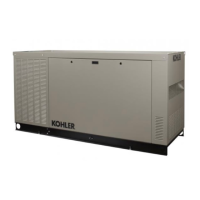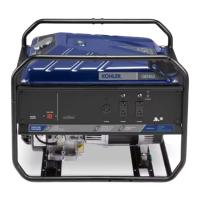TP-5393 9/933-6 Scheduled Maintenance
Spark Plugs
Every 100 hours remove both spark plugs and check
condition (see Figure 3-7). Reset gap or replace plug if
needed. Proper generator operation is indicated by a
lightdepositofgrayortanmaterialonplugelectrodes. A
dead white, blistered coating could indicate
overheating. A black (carbon) coating may indicate an
“overrich” fuel mixture caused by a clogged air cleaner
or improper carburetor adjustment.
NOTE
Do not sandblast, wire brush, scrape, or otherwise
service plug in poor condition—best results are
obtained with a new plug. Use only resistor-type plugs.
Set spark plug gap at 0.025 in. (0.64 mm) on gasoline
fueled sets and 0.018 in (0.46 mm) on LP gas fueled
sets. Tighten plug to 10-15 ft. lbs. (13.6-20) when
installing.
1-905
Figure 3-7. Removing Spark Plug
Gasoline Fuel System
Specification—Gasoline
For best results, use only clean fresh, regular grade
unleaded gasoline with a pump sticker octane rating of
87 or higher in the U.S.A. In countries using the
research rating method, it should be 90 octane
minimum.
Unleaded gasoline is recommended since it leaves
fewer combustion chamber deposits. Regular grade
leaded gasoline may also be used; however, be aware
that the combustion chamber and cylinder head will
require more frequent service. Gasohol containing no
more than 10% ethanol can be used if unleaded
gasoline is unavailable. Never use gasohol containing
more than 10% ethanol or gasoline containing
Methanol. Oil must not be mixed with the fuel.
Usefreshgasolinetoensureitisblendedfortheseason,
and to reduce the possibility of gum deposits forming
which could clog the fuel system. Do not use gasoline
left over from the previous season.
